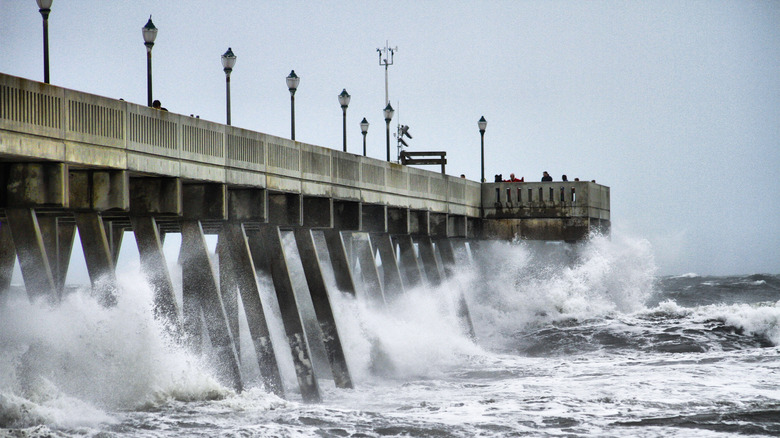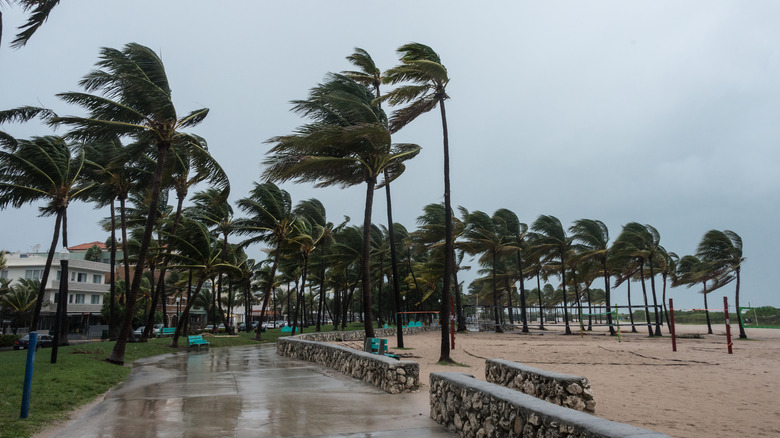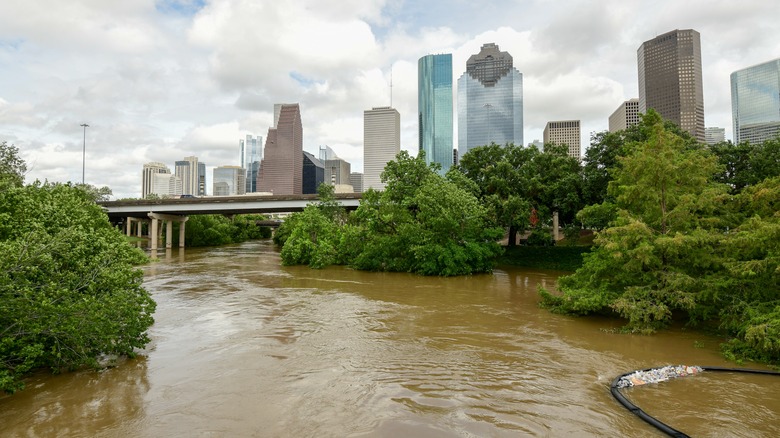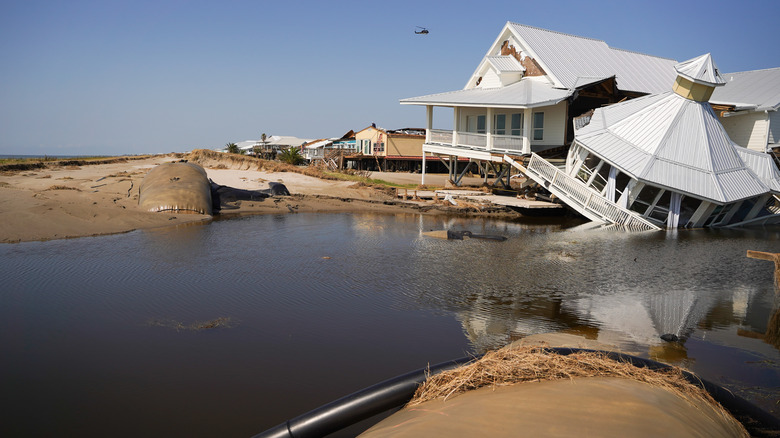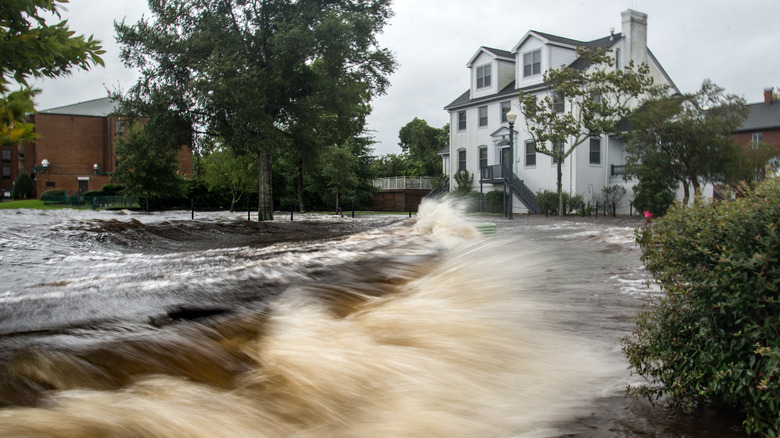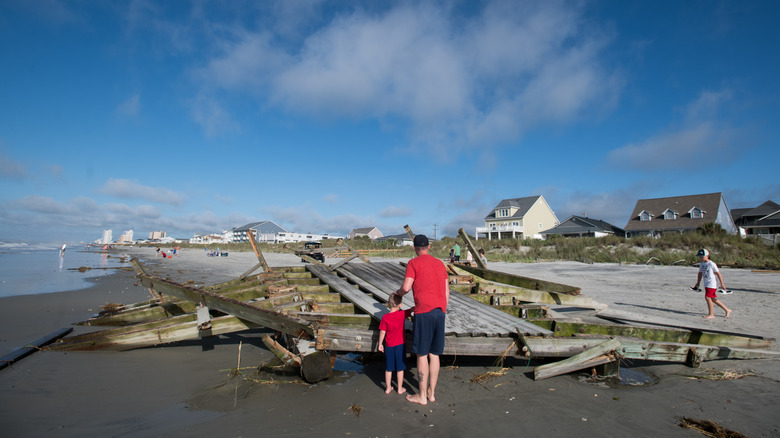5 Vacation Destinations In America That Are Most Likely To Get Hit By Hurricanes
Vacationers love summer, especially July. Yet, the most popular time for a getaway coincides with another season: hurricane season. Spanning June to November in the Atlantic Ocean, these tropical storms can impact vacations if you visit certain Southern U.S. states or parts of the East Coast. If you intend to kick back in any of these places during hurricane season, read up on travel insurance. While tropical cyclones don't constantly threaten any of these destinations, they can happen. On average, seven hurricanes and three major hurricanes develop in the Atlantic basin each year, according to the National Oceanic and Atmospheric Administration.
The threat of hurricanes extends well beyond the present day; experts point out that they will increase in intensity. "I think it's important for the public to take [this] seriously," Adam Sobel, a climate scientist at Columbia University, told NPR. "The storms are getting stronger. So even for the same number of storms, the number that are a real problem goes up because they are strengthening." With the danger rising, you may want to avoid one of these states and visit a hurricane-free Caribbean island, like Aruba or Bonaire, instead.
Florida
Since 1851, Florida has seen 125 hurricanes. According to the Florida Climate Center at Florida State University, the majority of tropical storm activity between 1944 and 2020 occurred from mid-August to late October. The center also noted that contrary to popular belief, no areas of the state are safe from hurricanes. "Since 1850, all of Florida's coastline has been impacted by at least one hurricane," the center notes. "With its long coastline and location, Florida frequently finds itself in the path of these intense storms." The same goes for even the top-rated islands in Florida, which will likely have more significant problems during and after a hurricane.
Unsurprisingly, three of the worst hurricanes ever to make landfall in the United States have hit Florida. These included the Category 5 Hurricane Andrew in 1992, Category 5 Great Labor Day Hurricane in 1935, and the San Felipe-Okeechobee Hurricane in 1928. Two of these huge storms happened a long time ago. However, due to the warming of the ocean, more major tropical storms in the Category 3-5 section have developed in recent years, per the Climate Center.
If you happen to be in Florida when a hurricane occurs, Visit Florida recommends evacuating if needed and staying up to date with weather changes. It also assures travelers that the hospitality industry has contingency plans in place for hurricanes. Thus, you should follow up directly with your booked companies.
Texas
Given that Texas is not a direct neighbor of Florida, it may surprise you to learn that the state experienced the second-largest number of hurricanes in U.S. history. Though, at almost half Florida's total, 66 tropical storms seem a lot less intimidating. However, the intensity, not the frequency, makes Texas' hurricanes so impactful. For instance, 2017's Category 4 Hurricane Harvey, which hit the Texas coast, made history as the second most costly natural disaster in the U.S. The 1900 Category 4 Galveston Hurricane also left a significant amount of destruction in its wake. The Galveston storm also killed between 6,000 and 12,000 people, according to the National Oceanic and Atmospheric Administration.
Texas storms like Harvey stand out because of their dangerous surge and subsequent flooding. Per the National Weather Service, a storm surge occurs when a "dome of water" overtakes the coastline when a tropical cyclone makes landfall. This is a particular problem in Texas due to "the shallow nature of the continental shelf east of the Texas Coast, a storm surge from a landfalling tropical storm or hurricane will be significantly higher compared with a surge striking the steeply sloped continental shelf along portions of the Atlantic coast," the NWS explains.
Louisiana
Just shy of Texas' 66 total hurricanes, Louisiana barely comes in third with 64. These storms are no laughing matter, though, since three of them number among the costliest hurricanes in U.S. history. The first, Katrina in 2005, caused a whopping $195 billion worth of damage. Nola.com notes, however, that a lot of the destruction from Katrina resulted from the levees failing in New Orleans as opposed to the tropical storm itself.
Unlike Florida, Louisiana has only faced one Category 5 storm, Camille, in 1969. Most hurricanes in Louisiana fall between Category 1 and 3. The state also has records of 20 uncategorized tropical cyclones between 1527 and 1846. According to WDSU, the majority of the Louisiana hurricanes develop in September because "wind shear and dry air are at their lowest," which not only helps hurricanes develop but can also make them stronger.
If you visit New Orleans during hurricane season, you have a reasonable chance of encountering a storm. New Orleans has a 92% of getting hit by a tropical cyclone in a given year, per NOAA (via City of New Orleans). A tropical cyclone is classified as such until its wind gusts reach 74 miles per hour or higher; at this point it may be referred to as a hurricane, cyclone, or typhoon, depending on its origin.
North Carolina
You'd think that with a National Hockey League team named the Carolina Hurricanes, the Carolinas would get a higher number of tropical storms. North Carolina actually sees more hurricanes than its sibling, with a total of 60 since 1850 compared to South Carolina's 44 since 1851. The state's unique geography makes it more prone to tropical cyclone impact.
Per Ready NC, "All areas of the state – from coastal and sound counties to the mountains – have been impacted by hurricanes in the past 20 years." So, like Florida, no corner of the state is safe from a tropical storm's impact. However, it has never experienced a Category 5 hurricane, with the Category 4 Hazel in 1954 its strongest on record.
According to the North Carolina State Climate Office, the state faces weather effects even if a tropical storm doesn't make landfall. Between 1851 and 2019, over 303 storms that never landed impacted the state. North Carolina's hurricane season is at its highest between mid-August and the end of October, giving early summer travelers a bit of distance before the bulk of the storm activity rears its head.
South Carolina
A far cry from Florida's 125 hurricane record, South Carolina's 44 seem like a drop in the bucket. Of those, only four made landfall as major storms ranking Category 3 or higher, per the state's Department of Natural Resources (DNR). Like its northern sibling, South Carolina has also never had a Category 5 storm, the department added. However, that doesn't mean visitors shouldn't remain aware of the possibility of dangerous weather. The South Carolina Emergency Management Division notes on its website that South Carolina is "one of the most vulnerable states in the nation to be impacted by hurricanes and tropical storms."
According to data collected by the DNR, there is an 86% chance that a tropical storm system will impact South Carolina in a given year. That said, the data also indicates that a severe tropical cyclone has not made landfall in South Carolina in a few decades. For instance, the last Category 4 storm hit in 1989. Still, if you vacation in one of the state's coastal counties, including some of the beach vacation hotspots like Hilton Head, Kiawah Island, and Beaufort, during the height of storm season, ensure you monitor weather developments.
